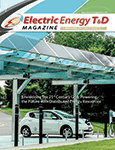The Electric Power Research Institute (EPRI) recognizes that today’s power grids and advanced grid initiatives need reliable, resilient, flexible, and secure telecom networks. Fiber optics networks play increasingly strategic roles as their uses move beyond teleprotection and supervisory control and data acquisition (SCADA). Electric utilities were among the first adopters of fiber-optic communications because its dielectric or non-conducting nature provides increased safety and reliability over copper-based wireline telecommunications.
EPRI’s Telecommunications Initiative is examining questions utilities have about fiber-optic networks as part of its six-part research investigation. See the September/October 2016 issue of Electric Energy T&D for more information about the project scope, which will be completed at the end of 2017.
EPRI’s collaborative approach brings together utilities and our technical experts to create consensus-based answers to these fiber network questions confronting utilities that are considering deployment or expansion of fiber optic networks:
- What are the best practices for installation, operation, and maintenance?
- What are beneficial uses for fiber networks beyond substation communications?
- Are shared fiber networks workable and what are the best practices and business models?
- What is the fiber lifecycle and the tradeoffs for cable types such as optical ground wire and all-dielectric self-supporting?
- How can we justify cost and secure funding for fiber networks?
Fiber – part of everyone’s diet and network?
The research topics in the Strategic Fiber track of the Telecom Initiative are based on a foundation of knowledge about fiber optic fundamentals for utilities. Our researchers documented the basics, such as cable types and their applications, network designs, and variable factors that influence equipment and installation choices. This step helps ensure that all research participants have accurate and consistent knowledge to inform their fiber decisions.
The research is developing an inventory of common utility fiber network uses as well as a review of other deployments that offer options for utilities. While the most universal utility applications include teleprotection and SCADA communications, our research identified five other potential applications that are deployed at utilities and can alter today’s fiber cost-benefit analyses and assumptions.
A web of ownership options and legal/
regulatory issues impact cost-benefit analyses
Many utilities are challenged with legacy and current decisions about fiber network ownership structures and the related issues of who operates and maintains these networks. Some have in-house resources and budgets that can support full ownership and these network assets, but other utilities face constraints related to staffing, funding, or regulatory policies that make third party ownership and-or maintenance arrangements more feasible.
Coupled with that are a range of legal and regulatory issues. Since telecommunications service providers have regulatory oversight at federal, state, and local levels, utility fiber decisions are strongly influenced by unique factors that probably change at state borders.
A key finding from our ongoing research indicates that fiber networks solely dedicated to serving utility locations have a much lower frequency of additions, moves, and changes of fiber connections compared to service provider networks. This contributes to a reduction in unintentional outages. That finding has implications for cost justifications, one of the most complex topics within fiber network discussions.
Fiber network investments have both capital and operational funding aspects that must be compared to alternatives involving hybrid or third-party ownership. Our research revealed interesting decision trends regarding capital versus operating expense when third party service providers are involved. Results also emphasize the importance of breaking down siloed perspectives by adopting a strategic analysis approach to fiber network decisions.
What’s next for utility fiber networks?
Two other common challenges were identified by surveys and assessments of Telecom Initiative participants. Utilities with legacy fiber have increasing age-related failures in that equipment, and lack experience in how to proactively plan maintenance tasks and procurements. Workforce issues of understaffing or absence of staff with relevant skills to plan, design, deploy, operate, and maintain fiber optic networks also loom large.
Our final fiber research report will be distributed to participating utilities by the end of 2017, although preliminary results are being shared now. This will not be the termination of our research activity into the roles and recommendations for fiber optic networks in utilities. EPRI’s 2018 telecommunications research will include investigation of potential methods for expanding fiber deeper into utility distribution systems to support advanced grid and distribution automation initiatives.
About the Authors
 Tim Godfrey is a technical executive with the Electric Power Research Institute, specializing in telecommunications. He manages the Telecommunications Initiative, a research project addressing the key challenges utilities face related to the telecommunications infrastructure supporting the smart grid. He holds a BSEE from the University of Kansas and has worked in the area of wireless networking and communications for 20 years. He has 23 granted patents. Mr. Godfrey has participated in IEEE standards development since 1994. He is the chair of the IEEE 802.24 Smart Grid Technical Advisory Group, and the IEEE 802.16 GRIDMAN Task Group.
Tim Godfrey is a technical executive with the Electric Power Research Institute, specializing in telecommunications. He manages the Telecommunications Initiative, a research project addressing the key challenges utilities face related to the telecommunications infrastructure supporting the smart grid. He holds a BSEE from the University of Kansas and has worked in the area of wireless networking and communications for 20 years. He has 23 granted patents. Mr. Godfrey has participated in IEEE standards development since 1994. He is the chair of the IEEE 802.24 Smart Grid Technical Advisory Group, and the IEEE 802.16 GRIDMAN Task Group.
 Christine Hertzog is a technical advisor for ICT and Cyber Security at the Electric Power Research Institute. She was previously the founder of a consulting firm focused on smart grid ecosystems and has an extensive telecommunications background. She authored the Smart Grid Dictionary, and co-authored Data Privacy for the Smart Grid. She has also served in an advisory capacity to innovators, industry associations, and publications. She has an MS in telecommunications from the University of Colorado, Boulder.
Christine Hertzog is a technical advisor for ICT and Cyber Security at the Electric Power Research Institute. She was previously the founder of a consulting firm focused on smart grid ecosystems and has an extensive telecommunications background. She authored the Smart Grid Dictionary, and co-authored Data Privacy for the Smart Grid. She has also served in an advisory capacity to innovators, industry associations, and publications. She has an MS in telecommunications from the University of Colorado, Boulder.







